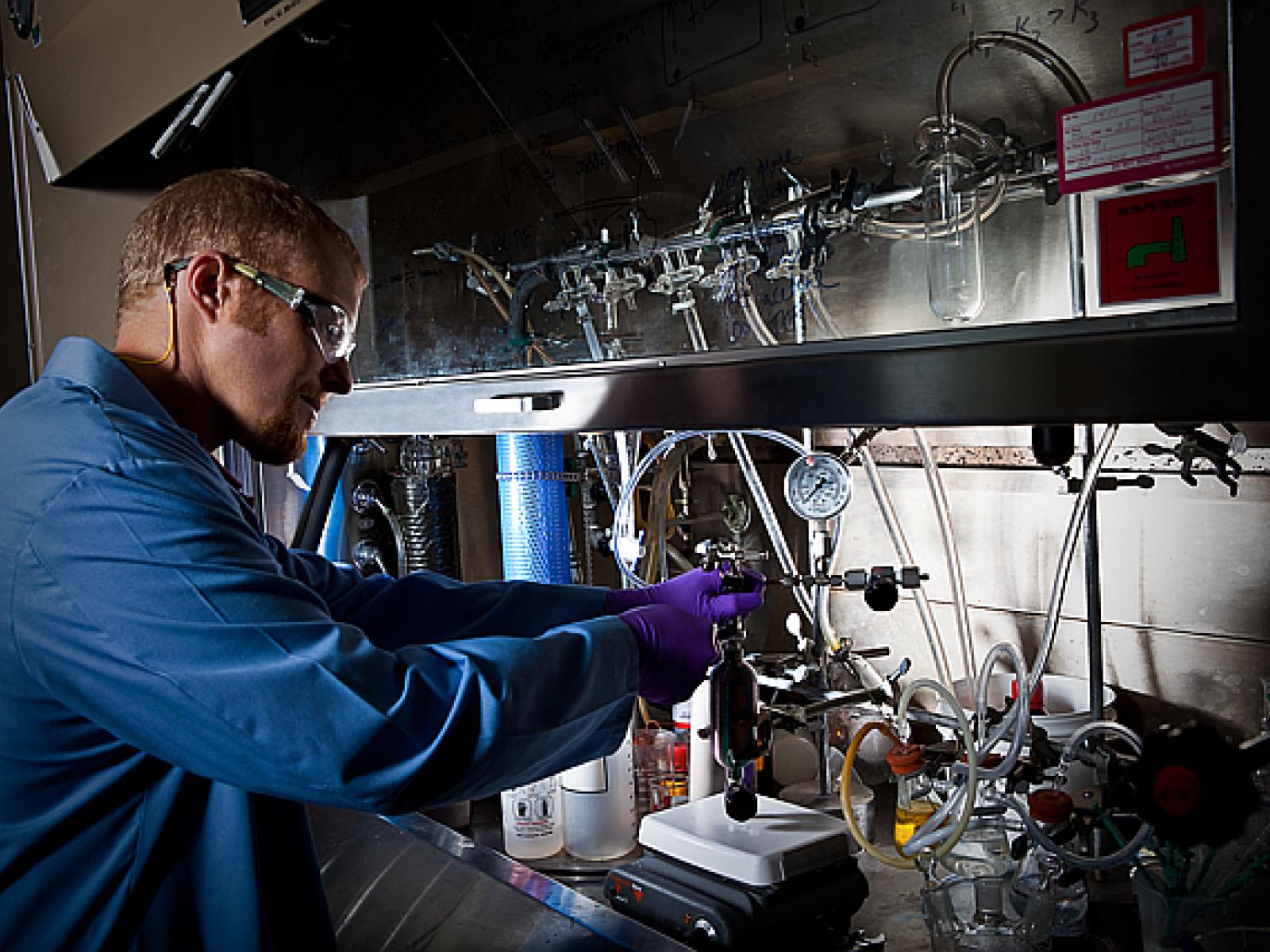International Workshop Leads to Path Forward for Clean Energy Research
PNNL’s David Heldebrant and 260 fellow scientists focused on worldwide collaboration and research in a carbon capture innovation effort

PNNL Senior Research Scientist David Heldebrant develops develops an ionic solution to capture toxic particulates including, carbon dioxide and sulfur that are associated with industrial emissions such as those from power plants.
Everybody relies on fossil fuels. These complex hydrocarbons are used to produce electricity, provide transportation and commerce, keep our homes warm, power industry, and they are an indispensable part of manufacturing. All this benefit comes at a cost— burning fossil fuels produces carbon dioxide (CO2).
With the aim of accelerating advances in clean energy, Mission Innovation is a global initiative of nearly two dozen countries and the European Union that has identified eight global challenges for research and development. They bring world leaders from government, industry, and science together to identify and prioritize breakthrough technologies and to recommend research, development, and demonstration pathways and collaboration mechanisms.
One of the organization’s eight global challenges is “carbon capture innovation.” In Houston—deep in the heart of America’s oil and gas industry—the Mission Innovation Carbon Capture, Utilization, and Storage (CCUS) Expert’s Workshop in September 2017 brought together 260 of the world’s top experts in carbon capture, utilization, and storage.
A shared vision of near-zero CO2 emissions
On hand was Pacific Northwest National Laboratory’s David Heldebrant, a chief scientist in the Advanced Energy Systems group of PNNL’s Energy and Environment Directorate. For three days, Heldebrant and his colleagues worked toward a vision of “near-zero carbon dioxide emissions from power plants and carbon-intensive industries,” explained Heldebrant.
“They asked us to sit down, brainstorm and then write what we feel are the critical research needs that should be the focus for industry and government agencies,” said Heldebrant, a widely acknowledged expert in solvent systems for carbon dioxide capture. In addition to participating in numerous discussions, Heldebrant presented an overview of how solvent technology is evolving versus what is already commercialized.
According to Mission Innovation, the goal of the challenge is twofold: Identify and prioritize breakthrough technologies; and recommend research, development, and demonstration (RD&D) pathways and collaboration mechanisms.
Scientists from 21 nations contributed to the report
The workshop divided participants into four topical themes—carbon capture; carbon utilization; carbon storage; and cross-cutting CCUS topics. Each thematic team was tasked with writing all the data, contributions and ideas into a report that presents a research plan and agenda for the 21 participating nations to prioritize their science programs and resources. The report, Accelerating Breakthrough Innovation in Carbon Capture, Utilization, and Storage (PDF), says Heldebrant, is an important technological approach that can help achieve long-term global carbon management goals.
It includes the 30 most promising directions for basic research (Priority Research Directions, or PRDs) that are needed to achieve long-term global carbon management. These PRDs encompass opportunities for understanding and improving materials, chemical processes, and other scientific and technical areas required to develop the next-generation technologies needed for efficient, cost-effective management of carbon emissions.
With an accord on research priorities, the international community is already providing resources for new research initiatives. But beyond these emerging and tangible results for research, Heldebrant believes a more important outcome is a sense of shared purpose. “We had 260 people from around the world come together, talk face-to-face and leave with a focus on more international collaboration and research. I definitely think that’s the best way to move forward.”
In addition to Heldebrant, the Department of Energy research complex was represented by individuals from Lawrence Livermore National Laboratory, National Energy Technology Laboratory (NETL), and DOE headquarters.
What is Carbon Capture, Utilization, and Storage?
While fossil fuels are expected to play an important role in the future global energy system; technical solutions are needed to reduce carbon dioxide (CO2) emissions from fossil fuel combustion. Carbon capture, utilization, and storage (CCUS) is a key technological approach that can achieve this goal.
According to the report, Accelerating Breakthrough Innovation in Carbon Capture, Utilization, and Storage, CCUS is a process that includes the separation of CO2 from a power plant or industrial plant effluents to be used as a feedstock for useful products or to be permanently stored deep underground in geological formations. CCUS can significantly reduce carbon emission across industries that range from cement, iron and steel production.
Published: July 25, 2018